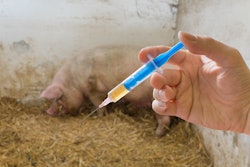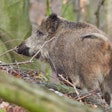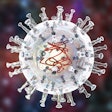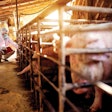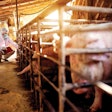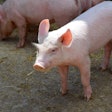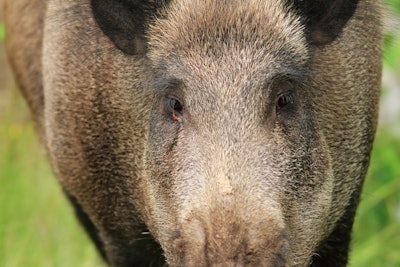
In recent days, the ASF situation has eased sufficiently for the state government of Saxony to announce a significant reduction in the size of the disease control zones. In a further development that will be welcomed by farmers in this eastern German state, strict regulations for agriculture are being lifted. The European Commission has authorized these changes.
First ASF cases in Saxony were confirmed in October of 2020. Since then, almost 2,400 wild boar have tested positive for the ASF virus. However, only one case has been identified since August of last year, and that was in February. No outbreaks among domestic pigs have occurred in the state.
As a result, the size of restriction zone II has been halved, and the area of restriction zone I (buffer zone) has also been greatly reduced. Of the 850km of fencing erected to control wild boar movements in Saxony, 400km has already been removed. To reduce the risk of the reintroduction of the infection from Poland, some of these barriers and control zones will remain in place.
In other German states, ASF cases in the wild population continue to be detected.
Latest official notifications to the World Organisation for Animal Health (WOAH) cover 101 further cases in Hesse, three in Brandenburg, and one in Rhineland-Palatinate.
Of the 34 infections in wild boar reported by Germany’s national veterinary agency, the Friedrich-Loeffler Institute so far this month, 32 were found in the central state of Hesse, and two in Baden-Wurttemberg in the southwest.
9 European states report new cases in wild boar
So far this year, 17 countries have logged a total of 5,665 outbreaks of ASF in their respective wild boar populations.
This is according to the Animal Disease Information System, which is operated by the European Commission (EC; as of May 7). The System monitors selected listed animal diseases in European Union member states and adjacent countries.
For comparison, 21 countries registered a total of 7,892 ASF outbreaks in wild boar through the EC System during the whole of last year.
Further cases added in nine countries pushed up the total to date in 2025 by 99 compared with the previous week. Highest numbers of new cases were recorded in Germany (51), Hungary (25), and Italy (11).
So far this year, Poland has recorded the most outbreaks in wild boar (1,925), followed by Germany (1,212), Latvia (589), Hungary (494), Lithuania (397), and Italy (362).
ASF outbreaks in domestic pigs in Europe
Over the past week, just two new outbreaks affecting this population were reported to the EC System — one by each of Romania and Slovakia.
As a result, the combined total affecting domestic animals for the year to date stands at 202. One or more cases have been confirmed by eight of the region’s states.
In 2024, 16 countries logged a total of 764 ASF outbreaks in domestic animals with the System.
Recording the most outbreaks in this category so far this year has been Romania (now with a total of 132), followed by Moldova (33).
In recent days, the Romanian veterinary agency has notified WOAH about seven further ASF outbreaks in domestic pigs.
Starting in the period April 24 to May 6, these involved backyard herds — each comprising between two and 15 swine — in four different counties.
More cases on South African farms
To WOAH the South African animal health authority has reported two more ASF in domestic pigs over the past week.
Affected were two small farms in the province of Gauteng — one with 40 animals, and the other with a herd of 60. While the larger of these was hit by the disease in early April, the other was confirmed as starting in mid-January.
In this long-running disease series that started more than six years ago, 214 outbreaks have been reported to WOAH. All of these occurred outside the South African ASF control zone.
ASF developments in Asia
In the northeast Indian state of Mizoram, ASF continues to spread gradually since its reemergence there in March of this year.
With cases in four districts, around 400 more ASF-related pig deaths occurred there over the previous week, according to India Today NE (as of May 3).
In addition to around 3,460 animals that have died of the disease, a further 1,102 have been culled. Worst affected so far have been the districts of Siaha and Lawngtlai, where mortalities of 1,979 and 1,255, respectively, have been recorded.
With growing concern for the future of Mizoram’s pig sector, the authorities are reported to be continuing to enforce culling and containment measures.
As the risks of ASF spreading in another northeast Indian state — Assam — grows, authorities have banned movement of pigs, pork products and swine feed in or out of a designated zone in Kokrajhar district.
The move appears to have been prompted by the discovery of one or more ASF cases in a national park, reported Sentinel Assam in recent days.
After Zhemgang and Dagana, ASF has spread to a third district in Bhutan. This is according to the latest update on the ASF situation in Asia from the United Nation’s Food and Agriculture Organization. In April, cases were identified among in farmed pigs in Chhukha district in the southwest of the Kingdom.
Based on the latest data from the Department of Agriculture’s Bureau of Animal Industry, the ASF situation is gradually being controlled in the Philippines.
Compared with last year, there have been significantly fewer communities with ongoing outbreaks each month in 2025. However, the disease situation remains “active” in five regions — two on the island of Luzon, in Central and Eastern Visayas, and one on Mindanao.
In Vietnam, local media have reported ongoing ASF outbreaks in two regions over the past week.
So far this year, 70 outbreaks have been confirmed in 13 districts of Nghe An, reports BaoNgheAn. This province is in the North Central Coast region.
Of these, 53 outbreaks in 11 districts have been confirmed within the last three weeks. Around 1,700 pigs have been destroyed so far.
Meanwhile, ASF virus has been detected in pig meat in the South East region of Vietnam.
This resulted in the disposal of almost 800kg of pork products of unknown origin and without certification in Binh Phuoc province, reported VOV last week.
View our continuing coverage of the global African swine fever situation.
More outbreaks of Classical swine fever (CSF) in Japan
In late April, the nation’s veterinary authority confirmed to WOAH two further outbreaks of CSF affecting pig farms.
Presence of the CSF virus was detected at a farm with 5,915 pigs in Asahi city at the end of March. Within a few days, another outbreak occurred, this time in a herd of more than 7,360 swine in the Maebashi city area. These premises are located in the prefectures of Chiba and Gunma, respectively. Both are in the Kanto region, which is in central Honshu, and includes the city of Tokyo.
Last week, a further CSF outbreak was reported by the Japanese agriculture ministry. It was confirmed after a spike in pig mortality was observed at a farm with around 460 pigs, also located in Maebashi city.
These bring to 99 the number of confirmed CSF outbreaks in Japan’s domestic pigs since September of 2018. Of these, five have been reported so far in 2025, with the year’s first two outbreaks also in the Maebashi city area.
Among the nation’s wild boar, thousands of cases have been detected since 2018.
Like ASF, CSF (also known as hog cholera) is a notifiable disease that affects members of the pig family, according to the WOAH CSF page. Both diseases cause devastating losses in domestic and wild populations, but do not impact human health. Despite the similar names and impacts, CSF and ASF are caused by unrelated viruses.



